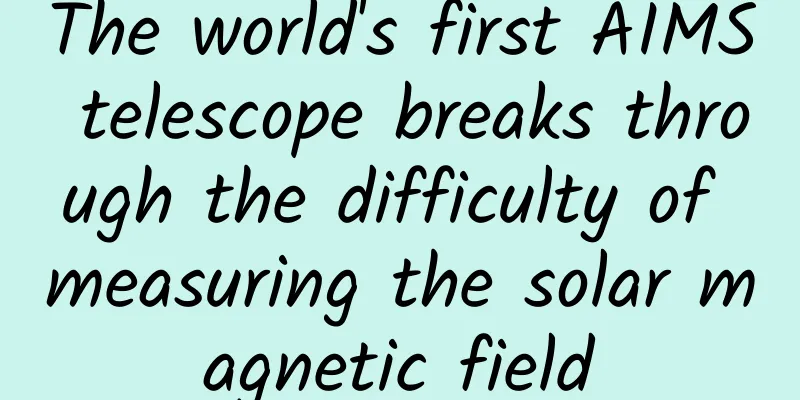The world's first AIMS telescope breaks through the difficulty of measuring the solar magnetic field

|
Reporters learned from the Qinghai Lenghu Astronomical Observatory that the world's first "mid-infrared observation system for precise measurement of the solar magnetic field" (AIMS telescope for short) has achieved its core scientific goal - improving the accuracy of vector magnetic field measurements by an order of magnitude, and realizing the leap from "indirect measurement" to "direct measurement" of the solar magnetic field. The AIMS telescope is a major instrument special project (recommended by ministries and commissions) supported by the National Natural Science Foundation of China. It is located on the D platform of Saishiteng Mountain in Lenghu Town, Mangya City, Haixi Mongolian and Tibetan Autonomous Prefecture, Qinghai Province, with an average altitude of about 4,000 meters. It is understood that after more than five months of preliminary debugging and observation, the current technical indicators of the telescope have met the requirements of the task book and entered the acceptance preparation stage. Wang Dongguang, chief engineer of the Huairou Solar Observatory of the National Astronomical Observatory of the Chinese Academy of Sciences, introduced that scientific data analysis showed that the AIMS telescope has carried out precise measurements of the solar vector magnetic field with an accuracy of better than 10 gauss for the first time. "This means that the AIMS telescope has achieved the expected goal of directly measuring the Zeeman gap in the mid-infrared band to obtain the solar magnetic field strength using an ultra-narrowband Fourier spectrometer, breaking through the bottleneck problem in the century-long history of solar magnetic field measurement and achieving the leap from 'indirect measurement' to 'direct measurement' of the solar magnetic field," said Wang Dongguang. "The Zeeman gap is proportional to the square of the wavelength. Before the AIMS telescope, the solar magnetic field was mostly observed in the visible or near-infrared bands. Because the gap was very small, it was difficult for the observation instruments to distinguish. The AIMS telescope operates at a wavelength of 12.3 microns. Under the same magnetic field strength, the Zeeman gap increases by several hundred times, making 'direct measurement' possible." This is the main structure of AIMS photographed on April 8, 2023. Photo by Xinhua News Agency reporter Gu Ling The AIMS telescope is the world's first equipment dedicated to mid-infrared solar magnetic field observations, and will unveil the mystery of the sun in the mid-infrared band. "Through optical design to eliminate stray light and vacuum cooling technologies, we have solved the problems faced by infrared solar observations in this band, such as high environmental background noise and reduced detector performance." Feng Zhiwei, senior engineer of the National Astronomical Observatory of the Chinese Academy of Sciences, introduced that the infrared imaging terminal consists of three systems: infrared optics, focal plane array detectors, and vacuum cooling. All components, including the detector chip, are domestically produced. The terminal system is mainly used for monochromatic imaging observations of the sun in the 8 to 10 micron band, so as to study the material and energy transfer mechanism during the violent solar eruptions. In addition, the AIMS telescope has also achieved breakthroughs in technologies and methods related to mid-infrared solar magnetic field measurements, and realized the first system-level polarization performance compensation and calibration of a mid-infrared solar telescope in China. "The telescope system is the first to use an off-axis optical system design in Chinese astronomical observations. In addition to the 8 to 10 micron infrared monochromatic image, the focal plane scientific instrument is also equipped with an internationally leading high spectral resolution infrared imaging spectrometer and polarization measurement system." Wang Dongguang introduced that the development of the AIMS telescope, in addition to playing a leading role in the precise measurement of the solar magnetic field, can also find new scientific opportunities in the mid-infrared band, which is currently little known. According to reports, the AIMS telescope aims to provide more accurate solar magnetic field and mid-infrared imaging and spectral observation data to study the generation, accumulation, triggering and energy release mechanisms of magnetic energy in solar magnetic field activities, and to study the transfer process of matter and energy during violent eruptions such as flares, and is expected to achieve breakthrough results in solar physics research. Planning: Liu Xinhui Reporter: Gu Ling Editors: Chong Dahai, Zhu Shun Produced jointly by Xinhua News Agency Domestic Department and Xinhua News Agency Qinghai Branch Produced by Star Studio |
>>: Brain death may not be true death? The blurring boundary of death
Recommend
User search behavior value: Analysis of the value of vertical search engine data
Vertical search engines are search windows provid...
It is said that a Chinese poet thousands of years ago "saw" the Earth from outer space...
The Mengtian Laboratory Cabin has recently become...
Double Eleven e-commerce advertising case!
On the one hand, competition for traffic is inten...
How to plan a professional online event?
Planning an event is not an easy task. It is esse...
Haibei teachers help children learn (family education)
Introduction to Haibei teachers’ resources for he...
Cai Wenchuan's "Photographer IP Camp, Issue 3" helps photographers increase their followers and monetize, and build their personal brands
Course Contents: Cai Wenchuan's "Photogr...
Constipated by overindulging in food and drink during the holidays? Don’t eat bananas! The real “constipation killer” is →
After indulging in eating and drinking during the...
Samsung S5 screen test
Bulgarian website Smartphone.bg praised the Galaxy...
RoboVM brings Java 8 programmers to iOS
[51CTO translation] RoboVM allows developers to u...
Father’s Day copy is here, it’s from the heart, not the body! !
Father's Day is coming. They are good at many...
Do you get goosebumps when you see "goosebumps"? It's not redundant at all...
Not only can he stand up to warm you in the cold,...
Daytime Research Society C4D Creative Design Course Gray Day - C4D IP Character Binding
Daytime Research Society C4D Creative Design Cour...
Why is it said that new energy vehicles will definitely be led by China?
The world is entering the era of electrification,...
Introduction and Use of Cosmetics
Introduction to cosmetics and their uses: Cosmeti...









